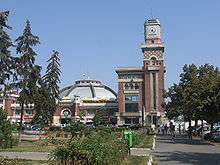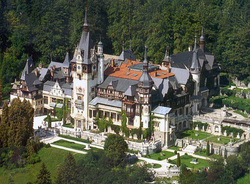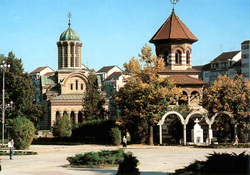City of Ploiesti

The town was established in 1596, during the reign of Mihai Viteazul (Michael the Brave). It rapidly flourished as a center for trade and handicraft manufacturing in the 17th and 18th centuries. The road connecting Ploieşti to Braşov was opened in 1864, and the railway arrived in 1882. Many schools and hospitals were built around this time. In the mid-19th century, the Ploieşti region was one of the world's leading oil extraction and refinery sites. The city is also remembered as the site of the self-styled Republic of Ploieşti, a short-lived 1870 revolt against the Romanian monarchy.
For more information: click here.
For more information: click here.
City of Sinaia

Sinaia is one of Romania's finest holiday resorts, located deep into the Carpathian Mountains. Situated in a breathtaking mountain scenery, Sinaia is located at 120 km distance from Bucharest and 49 km from Brasov, on the Prahova Valley. Sinaia takes its name from the 17th-century monastery built by a Romanian nobleman after undertaking a pilgrimage to Mount Sinai, Egypt. Sinaia is one of the most famous and oldest mountain tourist resorts in Romania, known as “The Carpathian Pearl”. It is best known for being the summer residence of the Romanian Royal family.
Sinaia is more than just a resort, it is history… The city is officially documented first time around year 1200. Its position, on the valley that connects Muntenia (the southern part of Romania) with Transylvania, made of Sinaia one important village from old times. The city’s orthodox church is the oldest proof and one of the interesting places to visit. But the most interesting place to visit in Sinaia is the Peles Castle. This is one of the best-preserved royal palaces in Europe. It served as the summer residence of the first Hohenzollern king of Romania, Carol I. Built in the latter half of the 19th century, it was the king's attempt to imitate the styles of his former homeland, creating a Bavarian setting in the mountains of Romania. The palace is ornately decorated, both the interior and the exterior, with intricate wood carvings and paintings of scenes from Wagner operas.
Sinaia is more than just a resort, it is history… The city is officially documented first time around year 1200. Its position, on the valley that connects Muntenia (the southern part of Romania) with Transylvania, made of Sinaia one important village from old times. The city’s orthodox church is the oldest proof and one of the interesting places to visit. But the most interesting place to visit in Sinaia is the Peles Castle. This is one of the best-preserved royal palaces in Europe. It served as the summer residence of the first Hohenzollern king of Romania, Carol I. Built in the latter half of the 19th century, it was the king's attempt to imitate the styles of his former homeland, creating a Bavarian setting in the mountains of Romania. The palace is ornately decorated, both the interior and the exterior, with intricate wood carvings and paintings of scenes from Wagner operas.
Targoviste

Targoviste has some impressive ruins of the Royal Court and Vlad the Impaler ruled the Country from there. His name appears on the list of voivodes of Wallachia at the entrance in he archeological site, near his ancestors from the Basarab familly (Mircea the Old, his grandfather, Vlad Dracul, his father, Radu the Handsome-his brother and so on). The whole Targoviste site is under restoration right now, the churches are closed, but everithing will be ready in October 2009. The most interesting place on that site is Chindiei Tower, which is in fact a Dracula Museum. The tower has 27 m high and about 9 meters in diameter and it survived to the centuries. In the top it is a good place to stay a while and to think about Vlad the Impaler and his role in the history of Romania. Especially because the Chindiei Tower was built by Vlad, in the second half of the 15th centrury.
Bran Castle

The Bran fortress was built on a cliff between Magura and The Hill of the Fortress, its position conferring an outstanding view towards both the hills of Moeciu and the ones from the Land of Bârsa. The building of the fortress was imposed by strategic and economic reasons. The strategic reasons underlined by the expansion of the Ottoman Empire which, by the end of the XIV century, began threatening the south-eastern borders of Transylvania; the economic reasons, given by the fact that the commercial road, one of the most important access ways connecting Transylvania to Wallachia, crossed this area.
